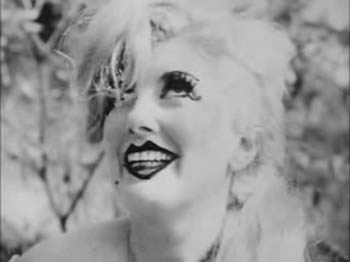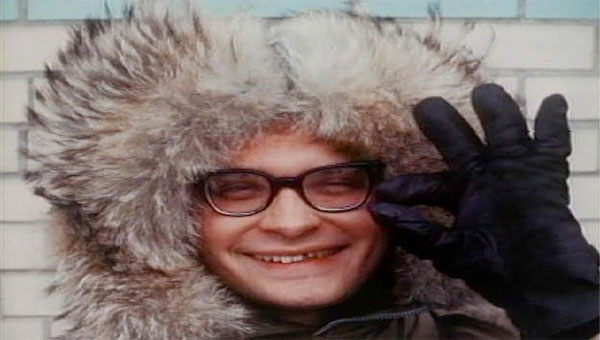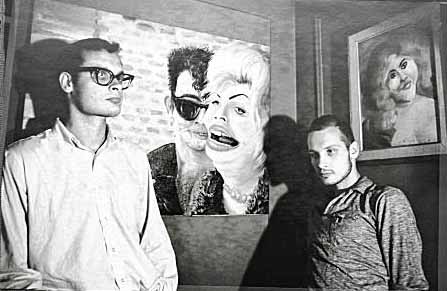“We aimed high and plopped all over the place but only time will tell if the stench was worth it.” Self-confessed anal expulsive George Kuchar is talking about the 16mm underground wonders, filmed in collaboration with his brother Mike, that shook up the Bronx in the early sixties. Their influence over Warhol, Waters, Vadim and Lynch is obvious; but the Kuchar Brothers have always worked for love, not money. Could you really call them camp? A camp film celebrates its inadequacies, but a Kuchar film is different – any inadequacy in production, character or performance holds poignancy and honesty as well as humour.
“It did not turn out that way because my students didn’t want alien digits diddling with their doings.”
 In the early 1970s George moved to California to teach at the San Francisco Art Institute. “Making films was a way for me to side step the physical and psychological angst inherent to that place. When my colleagues decided that the film students were fed up with theory and wanted action instead, I was only too happy to oblige them by volunteering to shoot movies in the classroom.” The idea was to have two separate classes: one to shoot and one to edit. “It did not turn out that way because my students didn’t want alien digits diddling with their doings.”
In the early 1970s George moved to California to teach at the San Francisco Art Institute. “Making films was a way for me to side step the physical and psychological angst inherent to that place. When my colleagues decided that the film students were fed up with theory and wanted action instead, I was only too happy to oblige them by volunteering to shoot movies in the classroom.” The idea was to have two separate classes: one to shoot and one to edit. “It did not turn out that way because my students didn’t want alien digits diddling with their doings.”
The students often strayed from the playtime fun of George’s studio to participate in his assistant’s saucier productions. “This was always a great tradition in the film department of the San Francisco Art Institute: students forming close knit crews to help each other out in the various chores of movie-making both behind and in front of the camera. It is a tradition that still continues today although maybe it is not as inbred and laced with hanky-panky as before. Or maybe it is and I’m out of touch with much behind-the-scenes action.”
If truth is stranger than fiction, Kuchar captures the truth in all its glorious grotesque. “Once, when I had brought in a real-life, psychotherapist to portray a character in one of our dramas, a female student approached the woman after class and broke down in tears. She needed advice on the road to womanhood and sought her expertise (not realizing that the therapist herself was a nut case).”
“I like to mix cheap effects with the new digital palette and make it look expensive. Whatever tools I have on hand is put to use to create what’s needed.”
George’s work is driven by nostalgia for the past, a love of improvisation and spontaneity, and a healthy attitude toward new technology. In the 80s he and his students moved from 16mm to video. The stigma attached to videotape, known for its cheap facilitation of the video nasty, saw George and his crew ostracised from their colleagues: “The class was quarantined like a sick sibling who drooled bile.” The technological dawn of the 90s brought DVR and digital editing which changed the face, but not the heart of Kuchar’s work. Although he can work miracles with miniature and matte, he embraces new SFX technology. “I like to mix cheap effects with the new digital palette and make it look expensive. Whatever tools I have on hand is put to use to create what’s needed.”
“I, by the way, was Dr. Butcher. Somebody had to try and save those monstrosities from being complete disasters”
As the power of movie making tools increased, the spectre of style over substance loomed: “Character development and plot took a back seat to digitally manipulated sequences designed to please the graphic sensibilities of Dr. Butcher, our editor. Since no one usually understood our pictures anyway (being that the original cast sometimes didn’t show up for shooting sessions, and the plots had to mirror who or what was available at the time) no tears were shed on this new development. I, by the way, was Dr. Butcher. Somebody had to try and save those monstrosities from being complete disasters”. One of Kuchar’s students at this time was Jennifer Kroot, the director of “It Came From Kuchar”. Originally conceived as a tribute to her mentor, the film focusses on George; but as Kroot learned more about Mike, she couldn’t leave him out of the documentary.
George’s directing style is symbiotic and not dictatorial. He builds a strong rapport with his students and comes to stylistic terms with them. In Kroot’s documentary Kuchar speaks of choosing collaborators who “understand” him – specifically, they understand that he’s broke. He describes his experience with the students at San Francisco as “an adventure in terror with some moments of horror thrown in. […] Thinking of plot development and lines of dialogue on the spot will hopefully be a factor in warding off the onset of Alzheimer’s as I inexorably age, and maybe the close proximity of the young will rub off onto my crinkling flesh like a Revlon elixir.”
George died on September 6, 2011.




One thought on “George Kuchar Interview”
Comments are closed.